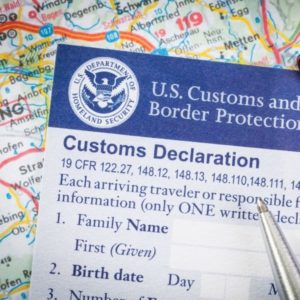 American customs can be daunting, even for a US citizen. I often get sweaty palms as I try to fill out the declaration form. I worry about getting answers wrong. I mean, if on my trip I went to a zoo in Australia, do I mark yes or no to having been on a farm/ranch/pasture? And does the banana I just ate on the flight count as a yes or no to the statement “I am bringing in fruits?”
American customs can be daunting, even for a US citizen. I often get sweaty palms as I try to fill out the declaration form. I worry about getting answers wrong. I mean, if on my trip I went to a zoo in Australia, do I mark yes or no to having been on a farm/ranch/pasture? And does the banana I just ate on the flight count as a yes or no to the statement “I am bringing in fruits?”
For me the pressure of US customs has increased as they go digital. In the past, I could contemplate the declaration form from the comfort of my airline seat. Now, at many international airports, you answer the questions at a kiosk. And if slow to answer, I envision the inevitably long line of passengers behind me turning into a restless mob. Which just makes me more nervous.
What is the solution? I have found it helps, to be familiar with the with the process. So, here is information on customs rules, regulations, and forms to review before you travel.
-
- What is Duty?
The first thing to know is that a customs duty is a tax designed to control the flow of goods across international borders. If an item is dutiable, then the tax needs to be paid. What is dutiable depends on many factors – where you bought it, how much you are bringing, and more. - Declare or Not
My biggest question at customs is always whether or not I actually need to declare something. Do I really need to declare a bag of potato chips I am bringing back? Well, yes. According to the US Customs and Border Protection website, anything you bring back that you did not have when you left the United States must be “declared” (www.cbp.gov) - Duty Free Allowance
Just because you declare something, does not make it dutiable. In fact, Americans returning home can bring in quite a bit of duty free items. In 2017, the duty-free personal exemption for a returning resident is $800 – unless you have been out of the country for less than forty-eight hours or more than once in thirty-day period – then it is only $200. If you spend more than that, you may have to pay taxes on your return. Although there are other exceptions – such as fine art, which is duty-free. And if you return from Guam, US Virgin Islands or American Samoa the duty-free allowance is $1,600.This is where my head starts to spin, there are so many exceptions to every regulation. That is why I like to quickly check before a trip what the rules will be when I return from that destination. You can find information on current allowances and exceptions at www.cbp.gov/travel/international-visitors/kbyg/types-exemptions.
One of my secrets for traveling abroad is to document what you spend. I keep a notebook of what I buy, where I bought the item, and the total cost. This really helps me when going through customs on my return to the States. In my travels, I have become a good negotiator, and I have purchased some amazing items for very little. When possible, I ask for a receipt. I do this so I can prove to the customs officials what I have paid. You see, if there is a special item I want and it is priced at $1300, but I negotiate it down to $750, I can buy it without paying duty when I return to the States. But if I can’t prove what I spent, and the customs official thinks it is worth $1300 as that is the going rate, then I may be required to pay tax even if I say I got it for less.
-
Duty Free Limits
Some items, most notably alcohol and tobacco, have limits on how much you can bring back tax-free. At the time or writing, the alcohol limit is one liter. So, if you bring back two standard bottles of wine (750 ml each) you are over the limit. That does not make it illegal. It simply means you are liable to pay the duty tax. Which in 2017, was a flat three percent on many items (although there are variations with this too). You may also have to pay IRS tax and state taxes. And be aware that for alcohol, the total number of bottles you can bring with you may be restricted by the law for the State you fly into. Rates and limits change, so verify at www.cbp.gov/travel/international-visitors/kbyg/customs-duty-info. -
Duty Rates
The duty rate is specified for pretty much every item a traveler could bring home and is determined by the Harmonized Tariff System. However, going through item by item is overkill for the average tourist. The US International Trade Commission does have a searchable tariff database (https://dataweb.usitc.gov/) but again, the average tourist does not need to know every detail. In fact, in traveling to over seventy countries, I have never needed to pay duty tax upon my return trip.With duty tax rates, there are again exceptions to the rules. If you bring back certain items (such as diamonds) from some countries you may have to pay a 100% rate of duty (so, as much in duty as you did for the item) if you exceed your duty-free allowance. I was surprised at the countries this increased duty rate applied too – Austria, Belgium, Denmark, Finland, France, Germany, Greece, Ireland, Italy, Luxembourg, the Netherlands, Portugal, Spain, Sweden, and the Ukraine. Luckily, items purchased by the average tourist do not fall into the “certain items” category. The tough thing is there is no easy list you can just go see.
On the flip-side, if you buy products from countries with special agreements with the US, you may be able to bring in extra duty-free items or pay a reduced duty if you exceed the allowance. In 2017, there were duty preferences for Canada, Mexico, Israel, Jordan, Chile, Singapore, Caribbean and Andean countries, and certain sub-Saharan African countries. For details on rules go to www.cbp.gov/travel/international-visitors/kbyg/customs-duty-info.
-
What If I Mail Items Home?
In our Wild Spirit Travel classes, we often get asked if duty can be avoided simply by mailing home the items purchased. The short answer is no. If you mail items back, they fall under the same duty-free allowances as if you carry them back with you. And you do not get an $800 allowance for what you bring plus another $800 for what you ship.
Now, if you mail a package home when on vacation, will the customs official at the airport actually know and demand duty? Not likely, but I advise filling out official documents truthfully, so you should include shipped souvenirs in your customs declaration form.
If you are simply mailing purchases home as a convenient way to not have to carry them around. Do know that at the foreign post office you need to attach a customs form. And in general, the same duty-free allowances apply as have already been discussed.
- Customs Declaration Form
I find it useful to be familiar with the customs declaration form before I travel. To see a sample form, go to www.cbp.gov/travel/us-citizens/sample-declaration-form. As the CBP moves to kiosks at airports, the number of boxes have changed. Instead of filling our all the personal information, the kiosk reads it off your passport. And I found the questions broader in scope. So instead of being asked if I was bringing in fruits, vegetables, meats, etc., it was just a general question about bringing in food.
-
If Connecting, Give Yourself Plenty of Time
On my first encounter with the kiosk, I was bringing in food, but it was packaged cookies and chips which I knew were allowed. Under the old declaration card, I would have been able to answer no. But with the kiosk, and the broad wording of food, my answer was yes. I was worried this would slow me down, and as I had a connecting flight I debated simply marking no. But as I said above, I advise filling out official documents honestly. So, I took my own advice, marked yes. Luckily, this did not slow me down. The customs official was quick and when I told her all I had was cookies and chips, she waved me on.Nevertheless, do give yourself plenty of time to make it through immigration and customs if you are connecting. I have missed more than one flight, when I have been delayed in this area.
-
What If I Shop at a Duty-Free Store?
Before you go on a shopping binge in a duty-free shop you should know a few things. First, items sold in a duty-free store are only tax free for the country in which the shop is located. Therefore, when you return home you still may have to pay taxes. Also, if you buy something in America at a duty-free shop before your trip, you are liable for taxes on it if you bring it back into the States with you.
- What is Duty?
By Shyla Esko Bare
July 27, 2017
© www.WildSpiritTravel.com
#traveltips #worldtravel #TravelSmartStrategies #TSS-B4UGo
